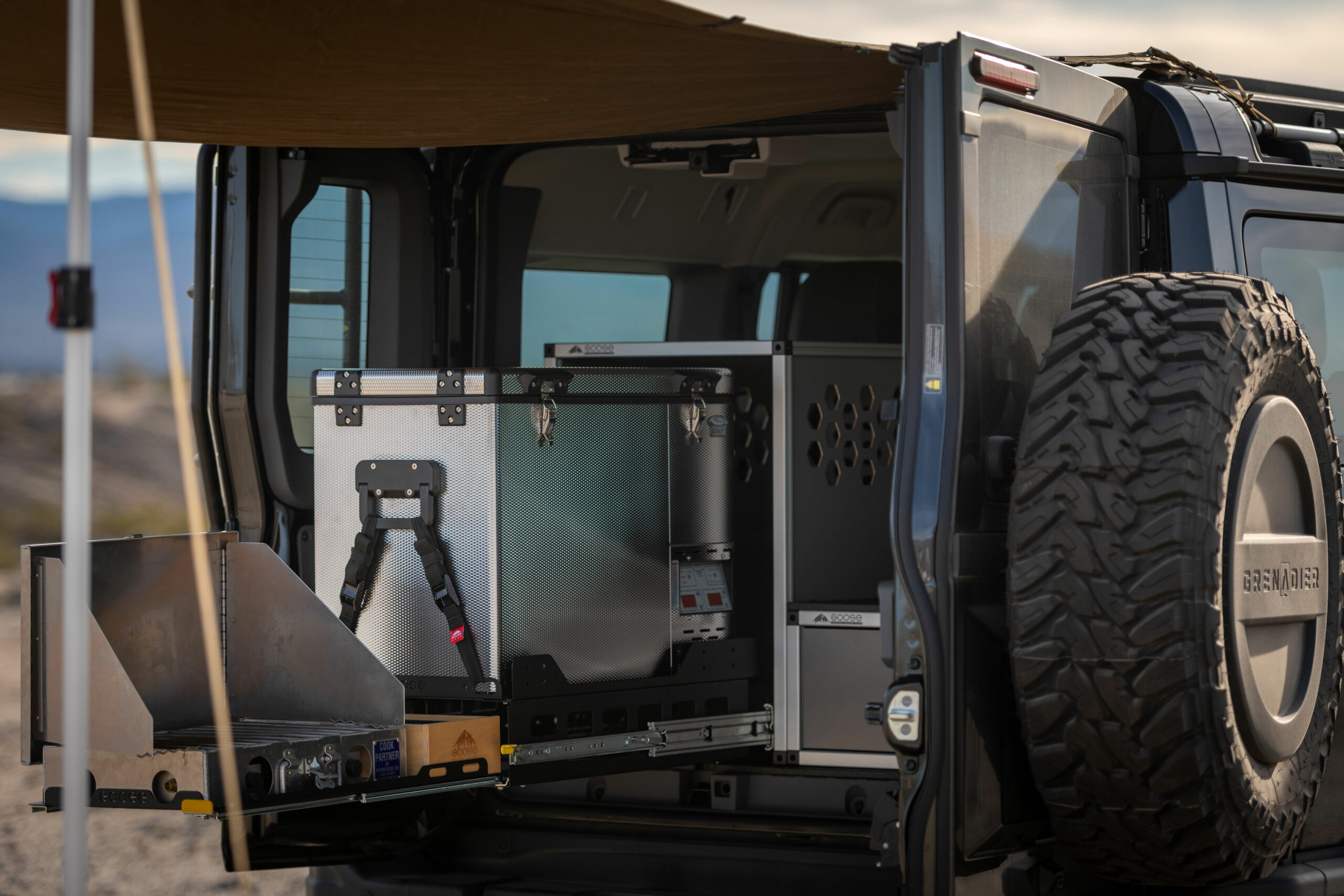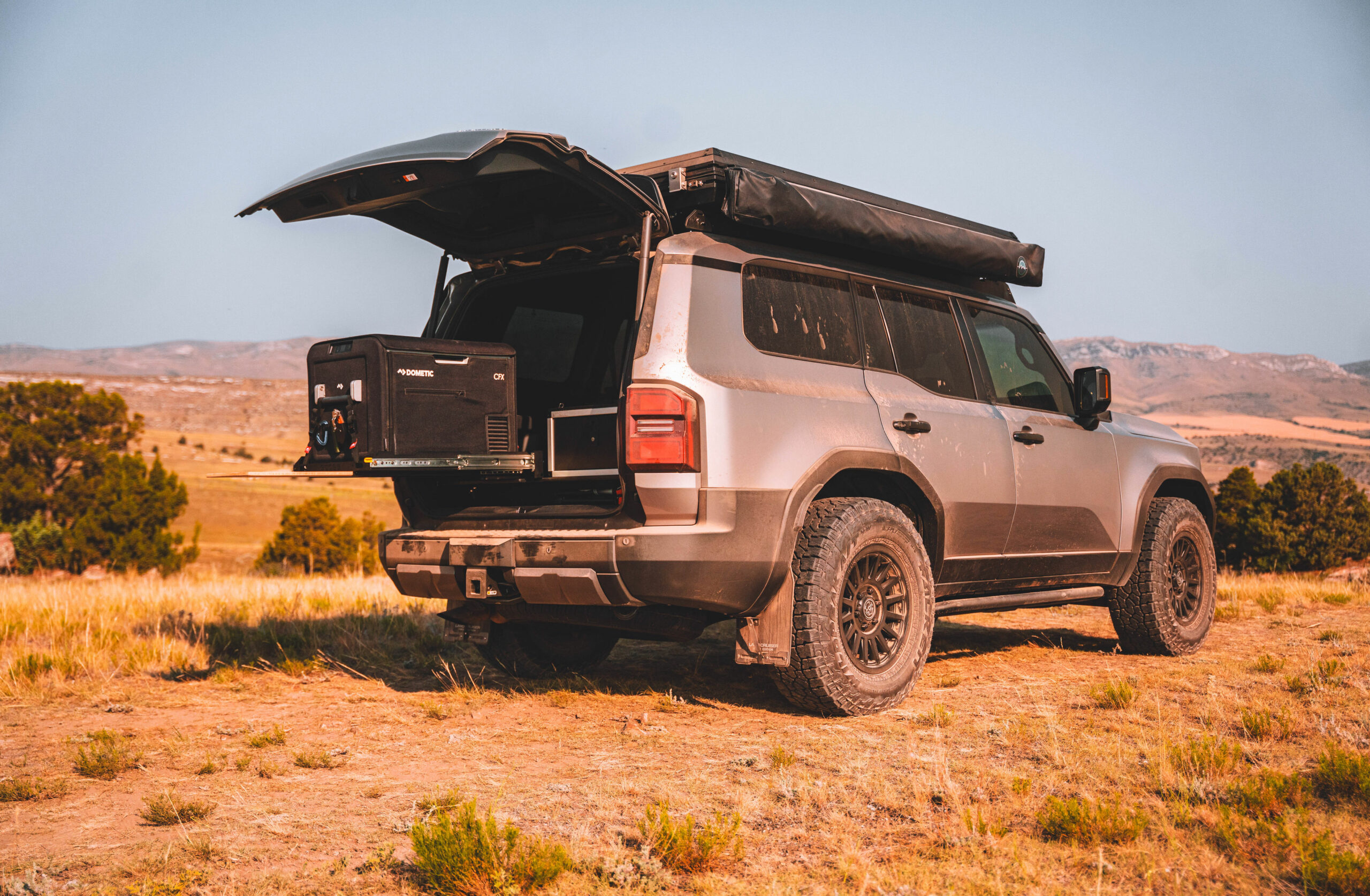In this installment of the Expedition Portal series on brands that inspire us, Senior Editor Ashley Giordano profiles overland industry leader and vehicle-based storage solutions manufacturer Goose Gear.
It’s easy to notice the quality of a Goose Gear product at a glance. Burly slides hold expertly crafted wood drawers. Marine-grade plywood coated with a proprietary blend of bedliner protects each cabinet top and baseplate. Aluminum extrusions act as an exoskeleton that ties each module together for the long haul.
The brand offers vehicle storage solutions, including base plates, kitchen modules, and drawers for just about any vehicle, including RAV4s and Subarus, as part of the Park Series, and pickup trucks, camper builds, and SUVs in the Explore Series. Last year, Goose Gear introduced its MaxLite technology, which resulted in a 26 percent reduction in the total weight of the Explore Series extrusion.
But to truly understand the brand and its past, present, and future, we must know CEO and Founder Brian Fulton. We must understand why he stepped away from a successful commercial cabinet manufacturing company and how that reason can be found in the name.
“When you look at Goose Gear’s success, we’re clearly doing something right,” says Goose Gear’s Director of Sales and Marketing, Ryan Hall, who knows Fulton’s desire is to make the best product. “It’s like Apple, right? Make the best product, and it’ll market itself.”
I recently connected with Fulton to learn more about the company’s origins, what they’ve learned along the way, and what the future holds for this company that recently flew east to Colorado.

Goose Gear began out of a desire to spend more time with your daughter, Aislinn. What was your “aha” moment?
In 2010, my wife left her family business, and we started our own cabinet manufacturing company. I worked 80 to 90 hours a week for the next four years. During that time, my daughter went from 6 to 10 years old. I would leave in the morning before she was awake and come home when she was getting ready to go to sleep. When she turned 10, I had this small panic attack and woke up in the middle of the night thinking, I’ve basically missed the past four years of her life. She’s my whole world so that just killed me.
I realized that something was missing before that, and I had been looking online, on YouTube, for four-wheel-drive trail videos. I had an old Toyota Pickup in high school, and instead of going to school, I would go wheeling with friends. So, I just started researching and came across Andrew St. Pierre White and the first season of Expedition Overland.
I was just blown away. You can go wheeling and camp, and then [continue] wheeling and then camp? That never even crossed my mind. As a kid, if we camped, it was at a KOA in the back of my dad’s slide-in camper, and we did it maybe 10 times in my entire life. I love wheeling. I love cars. I love the challenge. I decided that overlanding was what I wanted to do with my daughter.
How did you shift from working long hours to prioritizing time spent with your daughter?
I sold my F-250 work truck—a big crew cab long bed that we used to haul cabinets and stuff—and bought a 4Runner. When we built the 4Runner, I made a commitment to my daughter, promising to go camping for at least one month a year combined. We camped for about 36 days that first year. The next year, we camped over 60. We went out every other weekend and had a weeklong winter and summer trip. We camped out on the North Rim of the Grand Canyon in the National Forest during the winter. It was just epic.
Aislinn inspired the name of the company, too, right?
I don’t know how old she was—two or three months, maybe—when I walked into her room. I remember looking down in her crib and seeing her, and I said, “Hey, Goose.” That was it. Ever since then, I’ve called her Goose.

What is the story behind the first Goose Gear product?
Since we owned a cabinet shop and had a CNC machine and all kinds of cabinetry stuff, I researched and read the forums to figure out how people store their camping gear in the back of their vehicles. Expedition Portal and American Adventurist came across my radar. I saw that you could buy drawers from ARB. There weren’t a lot of options back then.
I did the research and thought I couldn’t afford $1,000 for ARB drawers, so maybe I’ll make my own. I wanted plastic bins to slide out and a little drawer in the middle. That’s what we built. We still have that drawer—it’s in the shop right now.
I threw the drawing up on American Adventurist, and the owner, Dave Bennett, reached out. He said, “I saw your drawing. Would you be interested in building something for my Tacoma with a Flippac?” Our Goose Gear camper system is based on the original design we saw in his truck in 2014. Dave gave me a solid education about the industry at that time and introduced me to a lot of really good people right out of the gate. That was a huge help.


You went from building cabinetry for buildings and homes to vehicle storage systems. What are the biggest differences between the two?
We did a lot of cabinetry building for the medical field, and there are different standards you have to meet for the American Woodwork Institute. For example, in hospitals, doors can be opened and closed 100 times every day, whereas in your kitchen, a door may only be opened and closed 100 times a year. Knowing how those things work from that cabinetry experience and countertop manufacturing side set a good foundation for Goose Gear.
However, with vehicles, there are limits on space and weight—a close third is durability. The vehicle is getting bounced to death on washboard roads and rocking motions front to back, start and stop. It’s not a house that’s sitting static. It’s a much different thought process designing cabinets for a vehicle—everything has to be overbuilt because of the abuse. It must be lightweight and bulletproof.
Tell me about Aislinn’s involvement with the Park Series.
The Park Series is our Subaru and RAV4 market, so we bought a Subaru Outback for her to drive. She wanted to get more involved, and it turns out she likes the wrenching side of the business. Next thing I know, she’s watching this YouTube video with her feet up in the headliner, and boom, she’s popping the whole headliner out of the car. The big thing she’s doing now is writing the instructions for new products, including the Sequoia and the new Tundra.
What’s your vision for the future?
If we’re making quality stuff, I’m happy. It has to be super easy to use and last forever. I hate stuff that doesn’t work or breaks. Most of our screws are custom-made for us, and our corner blocks are machined here in the States. We pulled a lot of weight out of our product in the past two years just by redesigning our corner blocks, fasteners, and bracketing. We’re also getting to the point where we’re implementing automation and efficiencies, and that’s going to allow us to scale while maintaining our quality, lead times, and growth.

What was one of your most memorable trips?
It was my first winter trip to Death Valley with Dave [Bennett] from American Adventurist. Dave is super military, like, wheels up at 7:00 a.m., and you’re going all day. But we saw so much stuff on that trip—it was unbelievable. It was fun but also taught me a lot about my vehicle and what you need and don’t need—like a crash course in overlanding. There’s definitely a push within the industry for lighter weight and being closer to GVWR. Less is more.



.
Our No Compromise Clause: We do not accept advertorial content or allow advertising to influence our coverage, and our contributors are guaranteed editorial independence. Overland International may earn a small commission from affiliate links included in this article. We appreciate your support.


